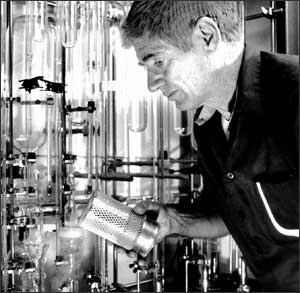
If you have followed discussions about global warming, you probably have seen claims that because atmospheric carbon dioxide concentration is measured on the top of a volcano (actually on the side - the measurement station is at the elevation of 3400m while the top of the mountain is at the elevation of over 4100m), and that volcanos emit carbon dioxide, the carbon dioxide measurements cannot be trusted. Thus the argument concludes that we don't know if atmospheric carbon dioxide concentration is rising or not. Here we take a look at what Charles David Keeling (1928 - 2005) wrote long ago.

As many of you probably know, Keeling was the one who arranged atmospheric carbon dioxide measurements starting in the 1950s, that resulted in the famous Keeling Curve, which describes the evolution of atmospheric carbon dioxide as measured in Hawaii, on top of a volcano called Mauna Loa. The measurement site was selected, because Hawaii is located in the middle of an ocean and far away from disturbing carbon dioxide sources. Also, the elevation of the location of the station ensures that measured air masses are representative of large areas. However, as the Keeling Curve is famous and is drawn from the measurements that originate at a site that has volcanic vents nearby, it is quite natural that there are claims made that the presence of the volcano somehow invalidates all our knowledge of atmospheric carbon dioxide. Many readers of course know that it isn't so, but here we look at what Keeling wrote about the issue in 1960. It turns out he had already debunked the claims, even before those claims were made.
In 1960, Keeling published the paper The Concentration and Isotopic Abundances of Carbon Dioxide in the Atmosphere (full text freely available in the linked abstract page). In this paper he discussed results from carbon dioxide measurements during a few years of observtions. Early in the paper he says:
"Three gas analysers, as described by SMITH (1953), equipped with strip chart recorders, have been employed to measure the concentration of carbon dioxide continuously at stations in Antarctica, Hawaii, and California."
So already from the beginning of Keeling's measurements there were other measurement stations besides Mauna Loa. End of story? Well, pretty much so for those claims, but anyway, let's take a look at what other things Keeling has to say on the subject.
Despite the reality, what if Mauna Loa was the only atmospheric carbon dioxide measuring station as those claims suggest? Would carbon dioxide measurements be suspect because of that? Keeling discusses this too. Keeling notes that there was local contamination in all of the measurement stations. In the Antarctica station there was some combustion of fuel near the station:
"It could be readily spotted from the significant fluctuations in the otherwise steady trace of the recorder pen and was eliminated from consideration in the initial reading of the charts."
In Mauna Loa, there also was some extra variability in the measurement record:
"This is attributed to release of carbon dioxide by nearby volcanic vents; combustion on the island associated with agricultural, industrial, and domestic activities; and lower concentration of carbon dioxide in the air transported to the station by upslope winds."
It seems that Keeling was well aware that "Mauna Loa is a volcano". He also identified some other sources of contamination. Not only was Keeling aware of the situation, he also knew how to correct it:
"The values reported here are averages of data for periods of downslope winds or strong lateral winds when the concentration remained nearly constant for several hours or more."
At a California measurement station there was an interesting situation. The measured carbon dioxide concentration was found to be highly variable:
"Highest concentrations occur during light winds from the north, from the direction of Los Angeles; lowest concentrations when the wind is from the west or southwest and of moderate force or greater."
Highest concentrations when winds were blowing from a large city? Why is that? Could it be that there is carbon dioxide coming from human actions?
Keeling then proceeds to discuss seasonal variation which he finds in the Northern Hemisphere but not in the Southern Hemisphere. Based on carbon-13 measurements, he concludes that the seasonal variation found in the Northern Hemisphere is from the activity of land plants. He also notes that timing of maximum and minimum concentrations match the timing of the land vegetation activity in the Northern Hemisphere. Keeling explains the absence of seasonal variability in the Southern Hemisphere by the smaller area of vegetation in the Southern Hemisphere.
Getting back to the claims of CO2 record contamination, Keeling then discusses the interannual trends in carbon dioxide concentration:
"Where data extend beyond one year, averages for the second year are higher than for the first year. At the South Pole, where the longest record exists, the concentration has increased at the rate of about 1.3 p.p.m. per year."
Note that Keeling reported the first clear increase in carbon dioxide concentration from the South Pole, not from Mauna Loa.
So, already back in 1960, Keeling knew that Mauna Loa was a volcano. He also knew how to correct the problems that the volcano caused for carbon dioxide measurements. He also knew that the volcanic problems wouldn't matter anyway because there were other measurement stations that were nowhere near any volcanos, and those stations show the same thing as Mauna Loa station - atmospheric carbon dioxide concentration is rising.
See also "Mauna Loa is a volcano" (also available as intermediate and advanced versions).
Posted by Ari Jokimäki on Tuesday, 21 August, 2012
 |
The Skeptical Science website by Skeptical Science is licensed under a Creative Commons Attribution 3.0 Unported License. |